This is a Smena-8 (Смена-8), a 35mm scale focus camera produced by LOMO in St. Petersberg in the former Soviet Union between the years 1963 and 1971. The Smena-8 was part of a long running line of simple Smena cameras that saw many iterations over the course of several decades of production. The Smena-8 was one of the best selling in the entire Smena line and was an important camera for the Soviet Union as it was one that was heavily exported to western countries in an effort to establish the Soviet Union as a maker of cameras. There are many variations of the Smena-8, some with Roman and some with Cyrillic names, and some with completely different names like the Cosmic 35 and Global 35.
Film Type: 135 (35mm)
Lens: 40mm f/4 LOMO T-43 coated 3-elements
Focus: 1 meter to Infinity
Viewfinder: Scale Focus Viewfinder
Shutter: Central Leaf
Speeds: B, 1/15 – 1/250 seconds
Exposure Meter: None
Battery: None
Flash Mount: Coldshoe and M and X Flash Sync
Weight: 327 grams
Manual (English): https://www.cameramanuals.org/pdf_files/cosmic-35.pdf
Manual (Russian): https://www.cameramanuals.org/russian_pdf/smena-8-1963.pdf
How these ratings work |
The Smena-8 is a basic and easy to use plastic camera made in the Soviet Union with a 5 speed shutter and an f/4 triplet lens, yet what it lacks in wow-factor, it more than makes up for in performance. Once you get over this camera’s many quirks, it makes getting quality shots very easy. My entire first roll from this camera came out in focus, properly exposed, and with a sharpness more indicative of a much higher spec lens. This is a camera that will surprise you. | ||||||
| Images | Handling | Features | Viewfinder | Feel & Beauty | History | Age | |
| 2 | 0 | 1 | 0 | 2 | 1 | 20% | |
| Bonus | +1 for unexpected quality of the images, in an otherwise remarkably strange camera | ||||||
| Final Score | 8.2 | ||||||
History

One of the longest lived and most successful of all Soviet cameras is the Smena (Смена). A theme carried throughout the entire series is that they were inexpensive cameras with simple interfaces and plastic bodies that were meant to be easy to use by notices.
The majority of the Smena series were made in the city of Leningrad, Russia in the GOMZ factory. GOMZ is short for Gosudarstvenniy Optiko-Mekhanicheskii Zavod which translates to State Optical-Mechanical Factory. Established in 1914, it transitioned to optical production in 1930 as one of the first Soviet factories to produce cameras and lenses. One of it’s first products was the folding Fotokor-1, which was an inexpensive copy of a German 9×12 folding camera, but in the years that would come, GOMZ would produce a dizzying array of models. Most GOMZ cameras were of the inexpensive variety which allowed them great success at introducing photography to the masses in the Soviet Union.

In 1939, GOMZ would release a camera with an all Bakelite body and a front “scissors” folding design called the Smena (Смена) which strongly resembled the Kodak Bantam. Designed by Ilya Grigoryevich Shapiro who was responsible for several other cameras including the later GOMZ Leningrad, the original Smena (which loosely translates to ‘change’ or ‘shift’) featured several improvements over the Bantam including a more versatile shutter, a focusing lens element, and a different viewfinder. Despite being a novel little camera, the original Smena was not in production long, likely due to Russia’s involvement in the war.
The GOMZ factory’s location in Leningrad spared it from destruction during the war, so once it had ended, GOMZ was one of the first Soviet factories to resume producing cameras and optical products.
In 1953, Ilya Grigoryevich Shapiro would once again release an inexpensive Bakelite 35mm camera using the name Smena, but this time, it was an all new design. Why was the name “Smena” used once again for an entirely different camera? On his site sovietcams.com, author Aidas Pikiotas hypothesizes that the release of the new Smena coincides with the death of Joseph Stalin and could have been seen as a “Change” in leadership, or it could have just been a coincidence. Whether any of that is true or not, is anyone’s guess and we’ll likely never know.
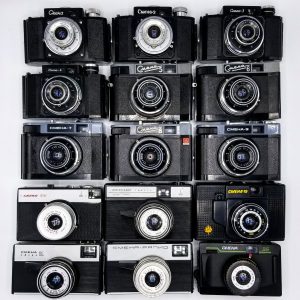
Over the next few years, the Smena would be continuously updated with additional features such as flash synchronization, a self timer, improved film advance levers, and improved shutters. An unofficial “first generation” of Smena cameras would last through the Smena-4 before being replaced by the all new second generation, starting with the Smena-5 which has a larger and more distinctly shaped two tone black and bluish/gray body.
The so-called second generation Smena consisted of five distinct models named sequentially from Smena-5 through Smena-9. The list of features of each of the five models was very similar with only minor changes between them all. It’s worth noting that a prototype Smena-7 was at one time proposed which would have had a selenium exposure meter, but it never went into production. Instead, the Smena-7 turned out to be a simplified version of the Smena-6. Confusingly, there was also a later Smena-8M produced between 1970 and 1995 which despite the similar sounding name was not at all like the Smena-8, featuring a completely different body.
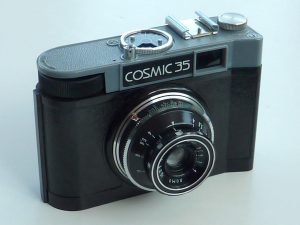
The Smena-8 being reviewed here was the highest featured of the second generation Smena models and the longest produced with several name variants exported to western countries as the Cosmic 35 and Global 35. The Smena-8, along with various models of the Zenit SLR were important for the Soviet Union as they tried to establish themselves in the export market as viable producer of inexpensive, but easy to use cameras.
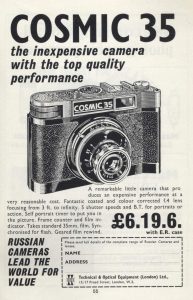
When exported to western countries, the Smena-8 was promoted as having an incredible value. I could not find any period advertisements showing US dollars, but the ad to the right from the UK lists the price as £6.19.6, which when converted to historical US dollars and then adjusted for inflation, comes out to roughly $150 today, putting it right at the same price point as an entry level point and shoot camera.
In 1962, the GOMZ factory would be reorganized as the Leningrad Optical-Mechanical Association, or LOMO for short, which is the name it still uses today. There exist Smena-8s with GOMZ, LOOMP, and LOMO markings, the LOOMP ones being the least common.
In the decades that would follow, a huge number of Smena branded cameras along with Smena variants such as the Vesna and Zenit-35F would be released. Although the look and design of the Smena series would constantly evolve, a common entry level feature set would remain. It is estimated that in total, over 30 million cameras were produced with the name “Smena” throughout it’s production run making it one of the most successful marques in the camera industry.
Today, the Smena series of cameras are what I call “accidentally collectible”. Outside from dedicated fans of Soviet cameras, not too many people purposely seek these cameras out, but they’re so common, most collectors usually end up with a few. These were highly mass produced cameras that are still very easy to find today, even in the United States, so picking one up is pretty affordable.
My Thoughts
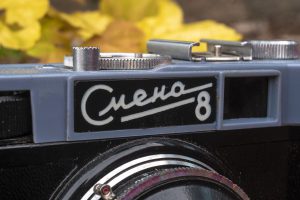
I’ve officially hit that point with my collection that I have cameras here that I can’t remember where they came from. I’ve heard these stories from other collectors who make a comment like “I opened up a drawer in my kitchen and found this Leica” and I think, how the hell can you have random Leicas in your house?
Of course a Smena-8 isn’t the same as a Leica, but nevertheless, this camera is in my possession and I don’t know how I got it. But that didn’t stop me from wanting to shoot it, if only to see how much (if any) of an improvement it was over the Smena-4 I previously reviewed which was riddled with light leaks.
From the very first to the very last Smena camera produced, these were inexpensive and simple cameras, aimed at the novice who didn’t want to spend a lot of money, but still wanted something better than a simple box camera with single element lens.
The Smena-8 continues that tradition with an entirely plastic body that weighs a mere 327 grams. Despite it’s light weight, the Smena manages to not feel cheap. The black and bluish/gray body fits comfortably in your hands with an angled corner, functioning like a simple hand grip that you might find on larger cameras, except on the opposite side of where you would expect it. Despite this oddity, the camera is comfortable to hold and has a nice feel to the plastic body.
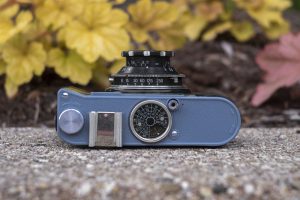
Other than it’s color, the top plate is unremarkable, with a small rewind knob on the left, next to an accessory shoe, combined film reminder dial and exposure counter, and cable threaded shutter release button. Film advance is accomplished by a wheel on the right, beneath the top plate.

From the back of the camera, you get a better look at the film advance wheel that works similarly to those found on cameras like the Olympus XA, except you can access it from the back and the front, allowing you to get a little more grip on it, which is helpful as I found the film advance on this camera to be a little stiff. The back door of the camera has a round circle with a rivet in the center that doesn’t do anything.
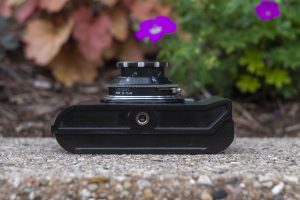
Continuing on the theme of a no-nonsense camera, the bottom plate features only the tripod socket, which unlike many other Soviet cameras is threaded for a 1/4″ tripod socket. Looking back at my review of the earlier Smena-4 which used the a larger 3/8″ tripod socket, I can only guess that the smaller size was chosen in an effort to make the Smena-8 more “international” as most western photographers had been using 1/4″ tripods for quite some time.

A look at the camera’s right side gives you an idea of the thickness of the camera’s angular grip, which for carrying the camera in your left hand is quite comfortable, but with the shutter release still on the right, this seems like a curious location. Perhaps it needed to be larger to accommodate the film compartment release lock, which is also on this side of the camera.
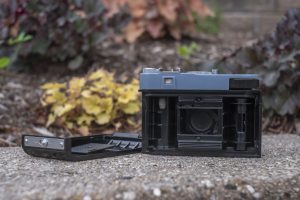
The Smena-8 has an entirely removable back that when released, reveals the film compartment. Film transport is from left to right onto a removable take up spool. In the image to the left, the original spool was replaced with the inner core of a 35mm cassette that lacks the correct slit for attaching a film leader. Not having access to the proper spool, I was still able to use this spool, but I had to use some electrical tape to stick the leader to the spool, otherwise it worked fine.
The distance from supply to take up spool is short, which has the advantage of allowing you an extra shot or two on the leader and trailer of every roll of film. Also note the film pressure plate which is strangely textured. Many pressure plates have small divots in them to decrease resistance as film travels across it, but the raised bumps here are a bit odd, but probably don’t hurt anything.
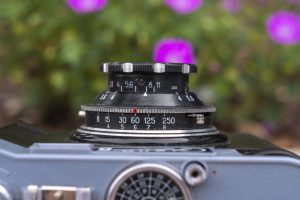
The Smena-8 really shows it’s discount nature with the 5 speed leaf shutter with manual cocking lever and rotating front element focus. Cameras with speeds from 15 to 250 are useful enough for film speeds that were common when it was first built, but the limited range of film speeds can be a problem for faster films these days. If you load in anything faster than 800 into the Smena-8, you’ll want to use it exclusively indoors.
Another oddity of this camera is in the focus scale. Written in meters, the marked distances are 1, 1.4, 2, 2.8, 4, 5.6, 8, 11, and infinity. It’s incredibly odd to me that the scale follows the exact same sequence of numbers used in the f/stop scale. In fact, the first time I picked up this camera, it took me a few seconds to realize I was not looking at the aperture selector, and rather the focus scale.
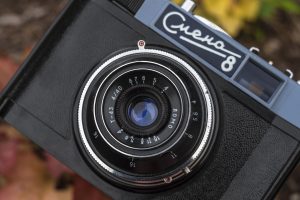
Changing f/stops requires turning an inner ring immediately around the perimeter of the lens similar to a Leica Elmar or Jupiter 12. On my example, this was a bit annoying as the entire lens likes to rotate as you try to turn this dial, and you also have be careful not to smudge the lens with your finger as you turn the ring.

The viewfinder is a basic straight through 1 to 1 design. There’s no Albada type lens here to modify the magnification of the viewfinder. Although this results in a very bright and easy to see through viewfinder, the lack of even a small amount of magnification makes seeing the edges of your image while wearing prescription glasses impossible.
Reading through this section of the review, the Smena-8 has quite a few oddities about it’s design that to someone who has never used it, add up to what seems like a pretty miserable camera to use. A removable back with an easy to lose spool, a strangely textured film pressure plate, simple shutter that has to be manually cocked, a bizarre focus scale with f/stop-like marks, and an aperture ring tucked in tight next to the front lens element that rotates the entire lens when changing, are all things that could turn away some photographers, but I guess any con can be overlooked if the images are good enough. Are they?
My Results
In the summer of 2020, my wife told me we were heading up to Michigan to visit her sister and dad, and as a reward for visiting her family, I could take as many cameras as I wanted. Oh yes!
The thing is, I’ve gone on these family visits before and despite all the good intentions in the world, I never have as much time as I’d like to shoot, so I had to pack my bag carefully. I wanted a diverse selection of cameras to shoot, trying not to duplicate too much of the same features in multiple cameras. In went a 35mm SLR, a medium format rangefinder, a folding camera, a fully automatic point and shoot, a panoramic camera, and after some careful planning, I had enough room for one more small camera. Sitting there on the shelf right in front of my face was this little Smena-8. I had a pile of Fuji 200 sitting in front of me, so I loaded up the compact Soviet camera with the Japanese film and threw it in my bag.
If the situation I described above sounds poorly thought out and at risk of complete disaster, you’re not wrong. The thing is, with shooting old cameras, sometimes no matter how hard you plan for a trip with the right camera and right film, things can still go wrong. The opposite is true too. Sometimes without any thought, the least likely pairing of camera, film, and location can produce some wonderful results, and I am happy to tell you that in this case, the latter is what happened.
I had shot a Smena before. My review of the Smena-4 was posted back in 2018 and I had a lukewarm experience with that camera. The shutter was iffy, it had light leaks, and after seeing the results from it, I was less than impressed. The Smena-8 on the other hand produced 24 out of 24 excellent shots, with vibrant colors, impressive sharpness, and a quality of images that I had to double check I was even looking at the right film after developing it.
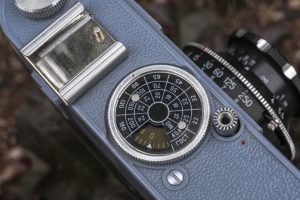
The inconspicuously named T-43 triplet is one heck of a lens and after looking at some other reviews online of this camera, it seems I was not alone in getting some unexpectedly nice images from it. Despite being a scale focus camera with no focus aides, getting properly focused images was easy thanks to the semi-wide 40mm focal length. According to the printed depth of field scale on the camera, at f/8 with the lens focused to 4m, everything from 2m to infinity will be in focus, at f/11 everything from 1.5m to infinity is in focus. To be perfectly honest, I didn’t think about focus too much while using the camera, doing my best to do ‘on the fly’ meters to feet conversion in my head and guess focusing, and well, just look at those images.
Coming to terms with exactly how I feel about the Smena-8 has been quite difficult. As you can see, the images it makes are great, and the ease at which you can get properly focused images, even without any kind of focus aide speaks to the success this camera had with novice photographers, but man does this thing have some strange quirks!
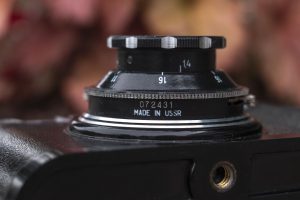
It’s a good thing that you generally don’t have to spend much time focusing the camera as the f/stop focus scale takes a bit of getting used to. Not once while shooting the camera was I able to frame the entire image as I wear prescription glasses and couldn’t see the edges of the frame. The speed at which I was able to fire off shots without having to worry about focus was at odds with having to remember to cock the shutter after advancing the film. And while not having the correct take up spool in the film compartment is hardly the camera’s fault, it required me to always have a roll of tape handy before I could load in a new roll of film.
It is curious that the Smena-8 turned out to be one of the most successful and important cameras for the Soviet photo industry with all of it’s quirks, but added together, it’s clear that the easy focusing and quality lens won over people despite the many other quirks.
In the end, I quite like the Smena-8, it’s pretty, and with a little bit of practice, most of the camera’s challenges will prove to be a non-issue for the repeat shooter. If however this is your first experience with one, be prepared to have some patience with it, but rest assured, once you see the results from your first roll, you’ll see that you have in your hands a highly capable photographic device.
External Links
http://sovietcams.com/index.php?1780124732
https://oldcamera.blog/2017/05/27/cosmic-35-aka-smena-8/
https://filmphotographyswapshop.co.uk/blog-videos/tag/smena+8
https://www.lomography.com/magazine/179132-cosmic-35-lovely-little-lomo-camera

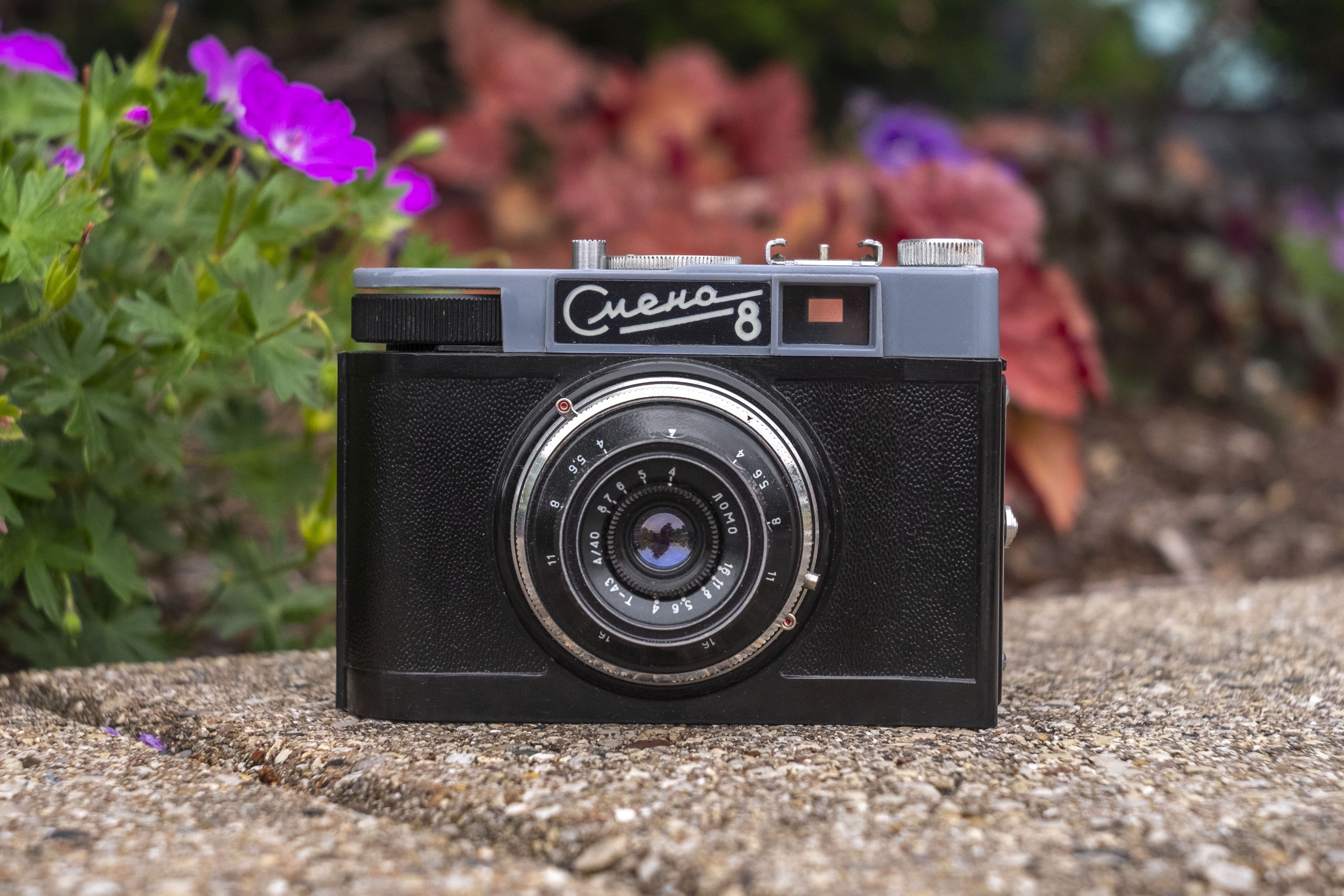
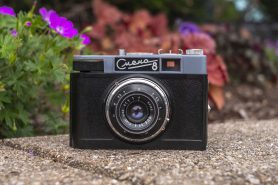
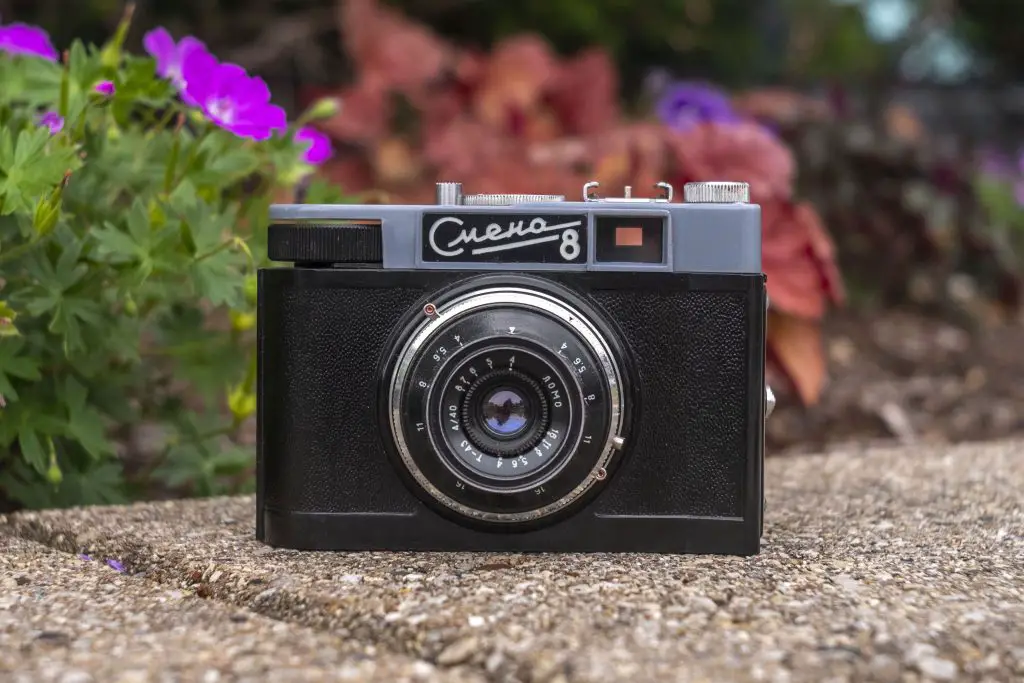














Mike i was amused to see the UK ad for the camera, it brought back a few memories. Printed on the bottom of the cut out is Technical and Optical Equipment the importers. I used to work for TOE in the late 70’s as a goods inwards clerk. Basically my job was to deal with all the broken cameras sent in the post from customers to get fixed. They were then sent upstairs to the Russian technicians. There were an awful lot of Zenith E’s, B’s etc and a few cosmic 35’s as well as other Russian cameras like the massive med formats, which nearly always had mashed up curtain blades, plus microscopes and huge radios with real wooden panels! I never did own a Russian camera at the time. They looked too fiddly and the markings were confusing (to me anyway). I stuck to my Olympus OM1n!
That Russian camera sure takes excellent very sharp images. Very impressive. It looks as good as shots from my Leica screwmounts and even close to being digital quality. Very interesting.
Thank you for posting on the wonderful Smena! I have more of them than I know, and am constantly finding them everywhere. The 8 is notably the first which has a rewind knob; all previous models presumed the use of a two-cassette system. The 3 and 4 had a wonky advance lever; the one on my only 4 didn’t function well and evaded repair. The top plate of two-tone bodies was apparently made of a different material prone to deterioration, at least on earlier models like the 5 and 6; which is a point of caution for collectors.
Hi,
Very nice pictures performed by Smena 8! There is a small defect seen on picture “Smena8-2” (with bridge), where you can see in verticals a parallel some light bands on right and left position. These are caused by shiny areas close to film space. The correction is very easy – take a knife and to brush a little to eliminate shiny parts to make them matt. I did it, proven, it works perfectly.
Jaroslav
Great eye and awesome tip, Jaroslav! Next time to take out my Smena, I’ll be sure to do that to see what improvements it could make!